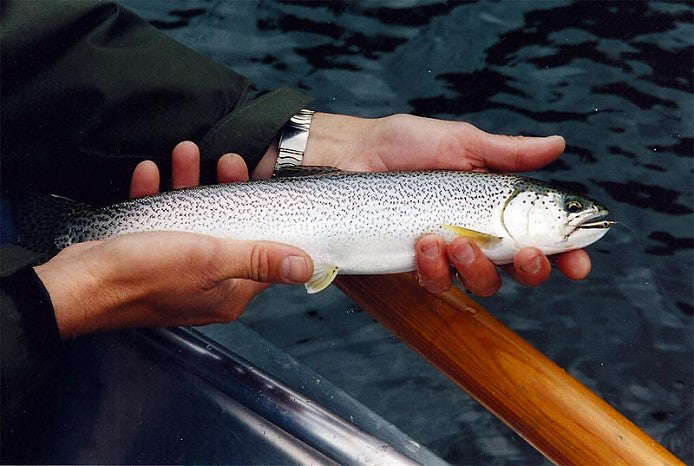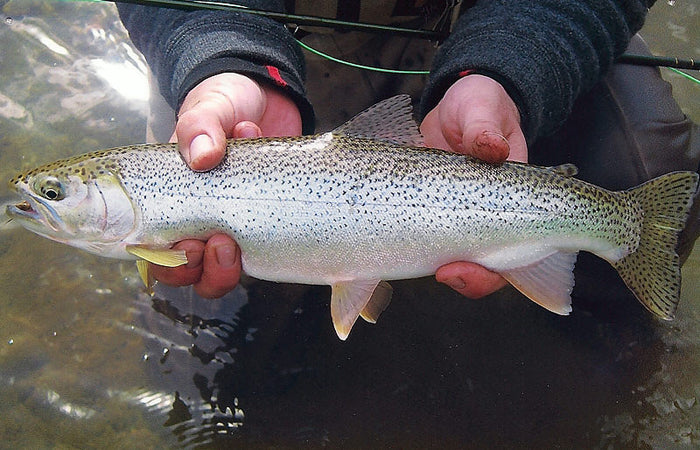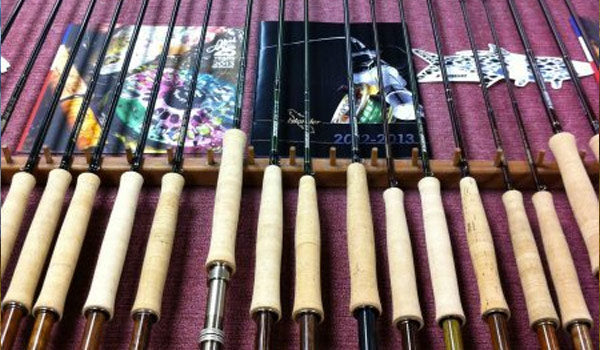Customer Login
If you are already registered, please log in.
Articles
There are more things to do than just fish for steelhead during the winter. It's not that we don't like steelhead, but it is not everyone’s choice of target. So if you want to mix things up a bit, or if steelheading just isn’t for you, there are many options available!
Most of our river/stream systems and saltwater beaches host either resident or sea-run cutthroat that can be surprisingly good. These fish can be caught with any method, whether it be casting lures, float fishing or casting a fly.
Resident fish throughout our area will generally be found in smaller tributaries to rivers such as the Fraser or Harrison. Sea-Run fish (anadromous/sea-going fish) can literally be found in any body of water that is not cut off from a tidal or migratory section, obviously including saltwater beaches.
Resident fish will move throughout their system, but sea-run fish are much more transient as they are constantly on the move and seeking out their next meal.
In this blog post we will concentrate on a couple of the main cutthroat fisheries within a wide spectrum of other opportunities.

These coastal cutthroat trout will find their way into any tributary that has a good food source. Once that food source has disappeared, they will most likely follow to the next area where they can feed. There is no real rhyme or reason as to where you may find them other than they will want to be where the food is.

The Fraser River Cutthroat Fishery
Mixing the words Fraser River and trout fishing can be intimidating for most anglers, but it is not as difficult as you may think. When we talk about trout fishing in the Fraser, we are mainly talking about the Fraser River backwaters and side channels in the Fraser Valley area. During the Winter months, river levels will generally plummet and clear which creates cleaner stagnant or slow moving backchannels.
Unlike some back channels you have fished on smaller steams, the Fraser River’s back channels can be the size of a larger river system so do not let this intimidate you. There are a few key pieces of info to factor into your day that will assist you with finding these fish.
First piece of advice we can give is selecting an area to fish for the day. Since this is such a large system, you will not want to spend all of your time driving long distances from spot to spot trying to find these fish. Pick a certain radius that you think you can walk and fish effectively, covering as much fishy water as possible. This is a not a fishery you cast blindly, looking for risers and feeding fish is absolutely key.

Now you may be asking what type of water are we looking for, and where exactly should we be looking? Think of it this way, the Fraser is already a large river as it is, no matter what the water height, but as a good rule of thumb the river will consistently drop through the Summer, Fall and into Winter.
The Fraser in the Fraser Valley area is made up of many back channels and braids which are full of water in the Summer, but as they progressively drop in level, these back channels and braids become much slower flowing, and at times even stagnant.
These channels do not even need an inflow of water, but still must have an outflow as an entrance for Cutthroat to move into in order to feed. Although, areas with inlet and outlet flows will be the best. Woody debris such as log jams or beaver habitat provides good cover for these fish.
If you can match similar spots to the ones we have described, you have most likely found yourself a good starting point. There is no necessary water depth within reason, but channels that have a deeper middle gut or centre, matched with a gentle sloping drop off are perfect feeding grounds for aggressive Cutthroat.
A full floating line or clear intermediate line is the best line for this fishery.
Helpful Hint: Do not be afraid to try indicator fishing small chironomids and midges as small as a size #18.

The Harrison River is one of the most scenic river systems in our area. It offers a spectacular wildlife and nature viewing, and can also offer phenomenal fishing in the Winter for trout.
The most common species that can be targeted and caught will be coastal cutthroat trout. After the salmon spawn in the Fall, eggs and pieces of salmon carcasses are drifting and floating throughout the river for these fish to gorge on. Once this food source diminishes throughout early Winter, the Cutthroat will generally key in on stickleback or smaller fish species.
Historically, between the months of January and March are when we see some of the biggest and meanest cuttthroat swimming around in the Harrison system looking for their next meal.

In a way, you will want to stalk and hunt these fish as we talked about in our Fraser River section, but a lot of this fishery is done in the mainstem of the Harrison itself. That being said, tributaries and creek mouths are also good areas to hunt these shiny bullets.

Finding Cutthroat in the Harrison is very similar to that of most places. Look for the action. This means jumpers, risers or surface sippers. At times, this can look like raindrops on the water.
A full floating line or clear intermediate line is the best line for this fishery.

One of the most exciting fisheries that we are lucky enough to have on our coast of British Columbia is a sea-run cutthroat trout fishery in the saltwater off our beaches and creek mouths. The cool thing about this fishery is no matter which beach you are on, and no matter where you are in British Columbia, these fish are something spectacular when it comes to overall endurance, fighting ability and aesthetics.
They are beautiful fish and most times they put up an acrobatic and spunky fight. There are many ways to approach these fish such as dry flies, sub surface flies or wet flies. The same token applies for hunting these fish as you would in the freshwater systems. Activity is key! Looking for rising and sipping fish will give you an upper hand.
There are many beaches in our local area where cuttthroat can be found, but finding them can be the tricky part of your adventure. Good times to fish your favourite beaches could be any time of the year. Fall, Winter, Spring, and Summer can all be excellent times depending on food sources available for the fish.

The Winter months can bring some of the best fishing available and this is a picturesque time of year to fish as well. Food sources range from salmon eggs and flesh, or salmon fry from inflowing creeks and river systems to crab larvae and shrimp.
When targeting Cutthroat on the beaches there is a huge variety of patterns to use. We suggest fishing a simple attractor pattern if you are having a tough time either locating fish or getting fish to strike. This would include flies like a Green California Neil, Coho Blue, Christmas Tree or Crab Larvae. We would recommend carrying a stripping basket or apron with you on your beach adventure as most times you will be standing in the water.
A full floating line or clear intermediate line is the best line for this fishery.
Whether you want to toss a fly or spinner, this is the fishery for you. Many areas where cutthroat are targeted are suitable for either style of fishing.

Fly Rods
Spinning Rods
Fly Reels
Spinning Reels
Fly Lines
Fishing Line
Leader Material
Fluorocarbon is highly recommended for this fishery. Fluorocarbon will give you an extra advantage if you are dealing with spooky fish in clear conditions, or any condition for that matter. The nice thing about this type of material is that it is 100% invisible.
We recommend:
There is a never-ending number of flies to use for these fish, and it will really come down to where you are fishing and what time of year as well.
Typical “go-to” attractor patterns include:
You will sometimes find brighter, more fluorescent colours to be good producers and then you may find more drab and dull colours to produce more fish on other days. We suggest having a box full of different variations in sizes and colour spectrums.
There is nothing particular for this fishery. A good variation of small spinners and spoons is all you need. Lighter spinners and lighter casting spoons of the silver and brass variety, paired up with a bit of extra brightness are effective, such as:
In Conclusion
Cutthroat are nomadic predators known for their aggressive nature and spirited fighting abilities. This local fishery can be a lot of fun regardless of your chosen angling method.
Post your questions in the comments section below or feel free to contact us by email searun2013@gmail.com, by phone at 604-931-5044 or stop by
Sea-Run Fly & Tackle at #110 1140 Austin Avenue in Coquitlam BC.
Good luck on the water.
Follow and Like Us
Like us on Facebook: https://www.facebook.com/searun
Follow us on Instagram: http://instagram.com/searunflyandtackle
Email us: searun2013@gmail.com
3 comments
Customer Login
If you are already registered, please log in.
Just wondering what the fly is in the left hand vertical row, fourth one down??
I tend to agree with Charles K. I am seeing far less cutties over the last 2 to 3 years.
Very likely VERY FEW hatchery. I understand the need to protect wild genetic stocks, but with ZERO explanation, provincial Fisheries has told Freshwater Fisheries Society to NOT stock the Fraser or any tributaries with cutthroat other than a very small amount of triploid. Therefore, since 2019 stocking in Lower Mainland tribs of Fraser has gone from roughly 29,000 annually to 2000 triploid in 2020 and 2021. I asked Freshwater Fisheries and they informed me that BC govt biologists in charge have made decision at local level. I wrote to them and they have not even had the courtesy to reply to my repeated emails in over 2 months. I would respect a evidence and scientifically based decision, but my observation is (been fishing cutthroat in Fraser system for 45+ years) that last year a few cutthroat but markedly down from prior years. What has increased greatly in last 2 years, though frankly over past 10 years is pike minnow, peamouth chub, suckers, and carp. When coho fishing (I have exclusively fished flies for past 30 years, though fishing partners have used spin gear) over past 2 years caught almost zero cutthroat whereas prior years usually a few every expedition (both hatchery and wild). Whitefish populations also seem to be down as well. In addition, invasive pumpkinseed, bass and crappie catches are becoming more common. The only really predatory fish that keeps these coarse and invasive fish numbers down is rainbow and cutthroat.